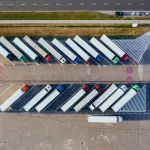Circular Supply Chains: Embracing Green Logistics and Plastic-Free Practices

Today, business is more than just a way of earning money – it’s an idea, a sense, and a message that influences the whole world. With the environmental problems being on the agenda, commercial companies are becoming more and more conscious of seeking more pure and eco-friendly solutions.
This new movement is supported by laws and regulations that are ensuring proper environmental protection and giving the green light to more sustainable practices. Such a landscape stimulates numerous changes in the logistics sector, which is responsible for up to 13% of carbon emissions.
Route and fuel optimization, elevation of electric trucks use, sensors, and AI-driven software for building new, more sustainable strategies, re-usable packaging – these are the trending aspects that are changing to slow down the environmental catastrophe and to meet the future: circular supply chains. Let’s review some of them in this article.
Policy Shift Toward Eliminating Plastics in Logistics
Sustainable changes are driven not only by business initiatives alone – they are strongly influenced by laws and regulations. March 2024 became a pivotal time when the UN Environmental Assembly (UNEA-6) adopted 15 resolutions to boost environmental protection and reduce pollution. Some of the new regulations are focused on reducing disposable plastic items and packaging use, along with tackling other types of pollution.
US businesses are responding promptly, designing reusable materials for packing and securing transported items, turning the supply chain into a less environmentally aggressive process. Yet, such a strategy provoked reorganization of other operations, raising a revolutionary tendency of smarter and more sustainable business management.
Transforming Waste into Useful Resources
Surprisingly, the attempt to protect the environment turned into a very budget-friendly move. While the implementation of more sustainable business practices often requires some financial investment, they are lately generously compensated with smarter policies of waste management and optimization of resources. A recent report based on Workiva Carbon investigation showed that most companies that are recycling plastic packaging and other items used for their daily operations are highly satisfied with the efficiency of those practices.
Circular economy models that are becoming more and more popular encourage businesses to use their resources as long as possible. It becomes a reality due to innovative, more effective ways of recycling, repeated use, and reintegration of potential waste. Such an approach helps to reduce carbon and plastic pollution, alongside cutting spending on disposable items and their utilization.
New Packaging: Smarter Materials like Bioplastics
While the ecological movement is still an innovation among commercial sectors, many companies are in search of their most sustainable solutions. That is the reason why we can notice the diversity and creativity at this point. Some companies, like Dole, are replacing plastic packaging with bioplastics, made of starch and sugarcane. These materials can be composted right after use without any noticeable harm to the environment. Others shift to recyclable PET plastic, as was done by Harmless Harvest. In both cases, the decisions led to significant improvement in sustainability and reduced long-term spending on packaging materials.
However, these are not the only advantages of a circular approach – these solutions also help to attract more customers, especially among younger people. A Harvard survey revealed that up to 30% of people aged 18-45 are more attracted to brands and producers who demonstrate their interest in eco-protective practices and offer environmentally-friendly solutions.
Easy-Open, Plastic Free Packaging for Online Orders
The developing sector of e-commerce is also shifting to more sustainable practices. Giants of internet commerce like Amazon are removing almost 15 billion plastic air pillows from their delivery packaging switching to recycled paper filling. In addition, such packages reduce the shipment cost and are strongly supported by the growing number of eco-conscious customers.
This solution has become a part of Amazon’s eco-development strategy that is aimed at using only renewable resources with zero carbon emissions and no plastic waste. While such an approach sounds as something futuristic, Amazon plans to reach its aim by the end of 2025.
Sportswear Brands Show the Way
Sports brands are taking the lead in the environmental movement, showing great creativity. Adidas has presented one of the most actively discussed programs, transforming plastic that was collected from the ocean into wearable clothes and accessories. Such a move is a part of Parley’s AID strategy that is aimed at removing plastic from nature.
The idea of sustainability is also strongly supported by sports teams and clubs. The first net-zero carbon match was recently organized by Tottenham Hotspur Football Club as part of the Race to Zero program. Causing a lot of rumors, the match has shown that even big sports events can be organized with minimal harm to nature and the environment.
Smarter, Cleaner Logistics with AI and Electrification
Reducing plastic use is important, yet not the only necessary change that circular businesses adopt today. The increasing number of logistics giants and smaller companies are switching to electric vehicles, and this change is becoming one of the most crucial to logistics operations. Electric and semi-electric vans and trucks help to reduce cost and maintain a stable workflow, in the condition of an unstable fuel market.
Another important innovation is the optimization of routes and supply processes with AI software. Such programs, alongside sensitive trackers, ensure constant monitoring and building errorless delivery strategies that can be promptly optimized when road conditions change.
Tracking Emissions in Real Time with Digital Tools
Tracking emissions allows evaluating the effectiveness of sustainable practices and understanding where to move. With an active implementation of reliable trackers and freight cost calculators, delivery chains have become more manageable and transparent. This brought many advantages, including a wider range of options to control harmful emissions. With real-time emission tracking and accurate budget planning, companies are able to cut fuel use by up to 20%, and this number is expected to grow with the development of AI-driven products.
Building Sustainable Ports to Support Circular Supply Chains
Green ports have become one of the most important sustainable solutions for today’s businesses. To lower emissions, green ports rely on cleaner fuels, efficient machinery, and streamlined cargo operations. Additionally, such ports provide opportunities for effective collection and recycling of waste.
Yet, such solutions are possible only in strong collaboration with circular supply chain processes. Common goals, shared information, and a similar view on the issues help to enhance sustainability and minimize possible harm to the environment.
Making Warehouses Greener with Smart Storage and Automation
With all those changes, warehouses couldn’t stay the same. Starting from simple solutions like energy-efficient lamps and ending up with using smart software for stock optimization, the way of storing goods and other items is becoming less costly and more environmentally friendly. Less use of disposable plastic, automated processes, and smarter space optimization – these are the most common updates in warehouse management and important moves for companies’ sustainability.
Conclusion
Circular supply chains and delivery services are at the heart of the uprising movement for sustainability as businesses face growing environmental and consumer pressures. New technologies like electrification, real-time tracking, AI-driven soft, green ports, electric vehicles, and smart warehousing are changing the way goods move around the globe. Companies that are implementing these changes aren’t just helping the planet or saving nature – they’re becoming more efficient and building a stronger reputation among customers. Sustainable logistics is no longer optional; it’s the future we can’t deny.




